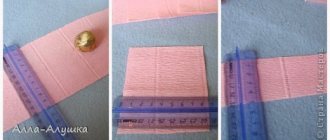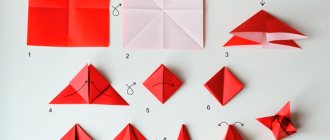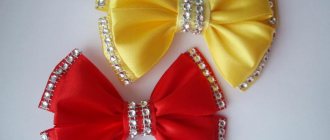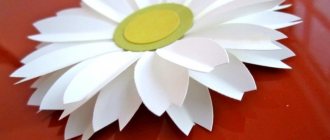Tips before you start
- The larger the airplane is planned, the denser the material should be.
- Small gliders can also be made from notebook sheets.
- All models must be made perfectly symmetrical, otherwise any aircraft will have a sideways roll.
- The folds must be pressed well; If you can't do it with your fingers, a ruler will do.
- Launch the aircraft at an angle of 45 degrees, unless the instructions recommend otherwise.
The easiest origami plane for beginners
The familiar model requires only 7 steps to create:
Editorial Voice
Irakli
Lord of Paper Sheets
Ask a Question
Make even and clear folds, watch for symmetry. Remember: the softer the plane is launched, the farther it will fly.
Simple airplane
Even for the first time, creating a model will be easy, following the step-by-step instructions. How to make an origami airplane with your own hands is described below.
- Take a rectangular sheet of A4 paper.
- Fold in half lengthwise, marking the middle, and spread out.
- Fold the top corners towards the middle, maintaining symmetry.
- Fold down the part of the workpiece with the corners along a horizontal line.
- Fold the top corners toward the middle again, but this time not right up to the center. You need to bend the corners so that an acute angle is formed between them, and a small diamond at the bottom.
- Raise the bottom corner of the small diamond until it stops, fixing the corners. Work the fold well.
- Fold the airplane in half lengthwise so that the folded piece is on the outside.
- Fold the wings towards the middle, bending them in half.
- The airplane is ready. You need to launch it by holding the small bent triangle in the middle.
A plane that flies well
A simple but interesting model is created in a short time from an ordinary sheet of paper.
Step-by-step instruction:
- Place the sheet of paper horizontally.
- Fold in half crosswise.
- Fold the resulting rectangle crosswise as well.
- Unfold and fold the bottom and top to the marked line.
- Unfold the workpiece.
- From the center line, bend the upper right corner so that it coincides with the right fold line.
- Repeat on the left.
- Bend the right side down along the midline.
- Repeat on the left side and straighten.
- Straighten the right fold to form a triangle.
- Fold the resulting part with the valley to the right.
- Repeat on the left side.
- Fold the side of the top right layer to the left along the fold line.
- Fold the entire fold down to the left.
- Repeat with the left side.
- Turn the workpiece over.
- Make small folds on the sides.
- Make folds towards the center line.
- Fold the workpiece into a valley.
- Fold the wings down.
- Fold down the flaps.
- The plane is ready.
In 1989, the Paper Aircraft Industry Association was founded. In 2006, the first championship for launching paper airplanes was held. Three disciplines were assessed: flight range, planning time and execution of figures.
Video instruction:
Happened?
Not really
Simple origami glider
Another easy-to-make airplane model, slightly similar to the previous one.
- Fold the rectangular sheet in half lengthwise.
- Fold the upper corners close to the middle of the workpiece.
- Fold the side corners towards the middle again.
- Fold the workpiece horizontally so that the upper corner aligns with the lower point where the side edges meet. It will hold the airplane's wings.
- Fold the product in half lengthwise, with the pocket corner facing out.
- Bend the wings, folding the triangular layers of the workpiece in half on both sides.
- The glider is ready.
Model with a strong “nose”
This plane has its own highlight. It lacks a sharp nose. Most paper airplanes end their flight by colliding with an obstacle. In this case, the nose becomes sharp and changes its geometry, which affects the flight.
A plane with a blunt nose is not susceptible to such deformations. The model is resistant to impacts on the wall and its service life is increased.
Step-by-step instruction:
- Place the paper vertically and bend the top corners towards the middle of the sheet. Fold the sheet in half so that the roof is inside.
- Unfold the sheet and fold the top corner of the rectangle down. The edges at the bottom should converge, and at the top the deviations should not exceed 10 mm.
- Press all the edges of the house and run your finger along the folds.
- Fold the product in half and spread the wings of the airplane.
Airplane “Duck” using origami technique
The airplane got its name due to its resemblance to a flying bird.
In addition to paper entertainment, there is a real aerodynamic design with this name. In this case, aerogami keeps pace with serious science.
How to make a "Duck"
The airplane is also made from an A4 sheet according to the following instructions:
- fold a sheet of paper in half lengthwise and lay it out;
- fold it in half again, but this time in width, and spread it out again;
- bend one edge of the workpiece to the middle along the width and unfold (clearly visible in the photo of the origami airplane);
- align the upper corners with the bend point, which was obtained after the previous folding;
- align the top edge of the product with the side fold and unfold it;
- repeat the operation on the other side;
- fold the sides along the marked oblique lines;
- open, pressing the top down;
- bend the “tab” of the pocket to the top;
- bend the small corners at the top of the workpiece towards you;
- fold the duck in half along the center longitudinal line;
- unscrew the wings as shown in the diagram;
- bend upward the narrow triangles along the edges of the wings.
The Duck plane is ready.
Model with beak
Place a sheet of paper horizontally. In this position, fold the sheet along the floors for the most part, and then unfold it. Connect the two upper corners of the sheet of paper on one side in the center of the sheet. The initial design should be the same as in the first assembly method.
Fold the top part in the center. You need to bend it so that the sharp end protrudes slightly beyond the base. Now you need to fold the outer corners of the resulting trapezoid.
You need to fold it so that the straight sides of the sheet are in the middle. Fold the resulting structure in half with the flat side facing inward. On the trail, you can bend the beak at the bottom of the plane and spread the wings 90 degrees from the body.
Fast flying aircraft modifications
Ordinary classic airplanes with no name. They are known everywhere and no one can say who came up with a specific folding method. But there are also real “stars” in aerogami.
For example, the current record holder for flight distance was invented by John Collins, a famous master of paper aircraft construction. The plane is named "Suzanne" in honor of the author's wife.
Before this record, the Japanese airplane Takuo Toda, a model with wide wings, was on the podium.
How to assemble modules
Modules are assembled from rectangular blanks. You can get them in several ways:
- cut the leaves of a square note block in half;
- draw and cut regular A4 sheets;
- buy special blanks in sets.
To assemble the module, you need to fold the rectangle in half lengthwise. Then mark the middle across and fold the corners of the workpiece towards it.
Turn it over and bend up the small corners along the edges. Lift the bottom part up and bend it in half along the center line. Assembly diagrams clearly demonstrate the entire process.
Each module will have two corners and two pockets, thanks to which it can be docked with other modules.











